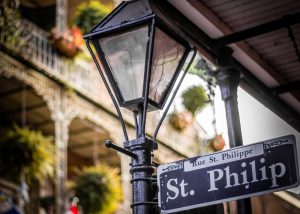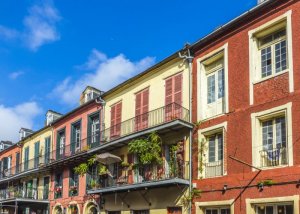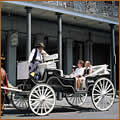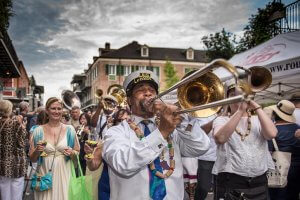The Rise of the Walled French Quarter Courtyard
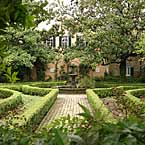
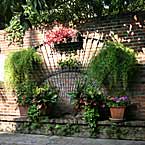
Top to bottom: The French Style Par Terre Garden of the Beauregard-Keyes House; An Ornamental Garden Wall of the Place d’Armes Hotel
Ask Maria Stankus what she does for a living and she’ll tell you she does nothing. In a sense that’s true, but she does nothing so well that people want to pose with her for photos and fill her tip jar with cash all day long.
Tropical walled gardens. Banana trees and gingers in shady enclosures. Wisteria and bougainvillea spilling over brickwork. Colorful cannas in mass profusion. Fragrant sweet olives reaching higher. The very notion of the walled garden suggests two-fold values. Urban living with privacy. Enclosed but outdoor spaces. The works of nature, green and flexible, with the works of mankind, solid and mineral. “No garden should be without a wall,” says garden writer Mirabel Osler in The Garden Wall. This seems to be a given in the New Orleans French Quarter. What was indeed a calamity for the inhabitants, when the town burned down twice in the late eighteenth century, gave rise to walled courtyards, which lasted. In the earlier Colonial period, the old French lots were wide and spacious. Houses sat in mid lot, with flat and spreading par terre gardens around them. The sunny potager or kitchen garden was a necessity. But after the two great fires, houses rose with new and closer alignments on deep but narrower properties. Adjacent buildings rested on common side walls (carefully computed as to costs, of course), and along the street the fronts were continuous. This pushed open spaces rearward, giving rise to walled spaces with vertical accents.
Creole chickens, guinea hens and privies out back
Sometimes numerous dependencies made the courtyard irregular and complex. Early Creole houses had detached kitchens, placed not at the rear line, but along the sideline or in the middle. The arrangement broke up courtyards into working spaces with an observable hierarchy. At the bottom of the “pecking order” was the basse cour, the rearmost space behind the kitchen, devoted to chickens, guinea hens and other comestibles–along with the privy. More prominent sections contained cisterns, corners for clothes drying, a place for some cooking chores, perhaps a well or a fountain. The rise of public markets toward the end of the eighteenth century made the colonial potager unnecessary in these spaces.
Ornamental features competed for space in working courtyards of the antebellum period. Building contracts tell us that the yards were always paved for work and traffic. Small, rounded brick gulleys carried water to the street on an imperceptible decline. Sometimes, a modest flowerbed was included in the courtyard. It might hold shrubs of althea, camellia, or pomegranate. Ferns, jasmine, and Rosa Montana could grow along a sidewall, staying out of trouble politely. When an owner had the equivalent of two lots, everyday work could proceed in the rear of the main house, while a French-style par terre flourished near it. Visit Beauregard House on Chartres Street or the Hermann-Grima House and Gardens on St. Louis Street to note this phenomenon.
Decaying courtyards as bathhouse and outhouse
Courtyard gardens were less detectable after the Civil war in the Quarter when yards were dirty and the immigrant poor used courtyard wells and fountains for bodily washing. Old photograph collections document well the condition of houses, with tottering outdoor stairways, peeling paint, and dependencies sinking progressively lower than their main houses. A renaissance was long in coming, but it gathered steam in the 1920s with bohemian attractions, the founding of the Vieux Carré Commission and historic district, and the arrival of architecture-loving residents. The old courtyards were still waiting for their gardening heyday.
Today you may enjoy the colorful bromeliads in the patio of Broussard’s Restaurant, the bright mix of perennials against the pink walls of the Historic New Orleans Collection courtyard, or the deep greens of luxuriant trees comfortably ensconced at Brennan’s or the Court of Two Sisters. But remember that the lush, tropical patio of the French Quarter, which we take as normal, was largely an invention of the twentieth century.
Sally Reeves is a noted writer and historian who co-authored the award winning series New Orleans Architecture. She also has written Jacques-Felix Lelièvre’s New Louisiana Gardener and Grand Isle of the Gulf – An Early History. She is currently working on a social and architectural history of New Orleans public markets and on a book on the contributions of free persons of color to vernacular architecture in antebellum New Orleans.
Related Articles
JOIN THE NEWSLETTER!
Talking to Statues and Feeling the Blues: The Quarter’s Rich Street Performance Traditions
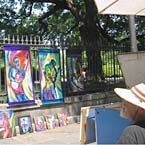
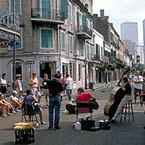
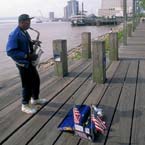
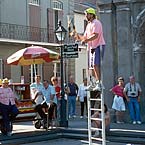
French Quarter Street Performers & Artists
Ask Maria Stankus what she does for a living and she’ll tell you she does nothing. In a sense that’s true, but she does nothing so well that people want to pose with her for photos and fill her tip jar with cash all day long.
Maria is a street performer in the French Quarter and, as a human statue, part of her job is to stand completely still. She can usually be found on the edge of Jackson Square with her skin covered in metallic gold paint, dressed in a matching antique wedding gown with an eight-foot train spread over the paving stones. Some visitors have dubbed her the Jilted Bride, and set against the backdrop of Spanish colonial architecture and the spires of St. Louis Cathedral she presents a visage that is ghostly and atmospheric.
She may be motionless, but she’s hardly doing nothing. Rather, Maria and those who ply similar trades in New Orleans are vital components of what makes the French Quarter such an intriguing and colorful place.
The French Quarter is the outdoor workplace for artists and musicians, tarot-card readers and fortune tellers, clowns and tap dancers and many others. Next door to the Café du Monde coffee stand, a high-energy troupe of tumblers works through a sidewalk floor show to a thumping hip hop soundtrack, while across the street a lone young man wanders the Square offering on-the-spot jokes for donations. Wander down Royal Street and you may find an escape artist wrapped in chains, a puppeteer, magicians in top hats and a lady of a certain age – known as Big Mama – who wears a church dress and veil and bangs out honky tonk numbers on an electric keyboard.
Lose Your Blues
“People come up and say ‘we moved down here because of y’all’,” says the Royal Street blues musician known almost universally as Grandpa.
Repeat visitors certainly have no trouble recognizing the 60-year-old harmonica slinger, with his bushy, snow-white beard, trademark overalls and tenaciously defended spot at the intersection of Royal and Toulouse streets. Blind in one eye, he wears silver-framed glasses with no lenses on which he has secured a small round mirror in front of his good eye. “It helps you see who’s talking about you behind your back,” Grandpa says.
People come to New Orleans for music and culture, he says, and street performers are right there to provide it amid the shops, restaurants and other attractions of the Quarter.
“A lot of people have the blues, even if they don’t know it,” Grandpa explains. “People go on vacation because they have the blues. They’re tired of their boss, they’re tired of the same four walls. When you need to get away from something, that means you have the blues. People come by and hear us and they can relate.”
Spontaneous Manifestation of New Orleans Culture
The street performance scene is perhaps most highly concentrated at Jackson Square, which is home to its own vibrant and newly resurgent artist colony. Art in the Square has been a part of the French Quarter since Civil War days when war widows are said to have sold paintings here to support their families. Today, it is the outdoor marketplace for an array of artists with a wide range of styles and backgrounds.
There’s William Warren, for instance, who taught both high school and college art courses in Providence, R.I., before moving to New Orleans. He now displays his vividly colored, almost fluid contemporary artwork on the wrought iron fence surrounding Jackson Square in the shade of oak boughs. While many performers follow the seasons and travel to other tourist destinations during the very hot New Orleans summers, William says most of his fellow artists in the Square work and live in the city year-round. William himself runs his own gallery, called the Waiting Room, along with his partner Pati D’Amico in the nearby Bywater neighborhood.
Every Day You Wake Up Is a Vacation
Many visitors are drawn to Jackson Square by the sounds of traditional jazz provided daily by a “house band,” alternately called the Jackson Square Band or the Jackson Square All-Stars. This varying amalgamation of anywhere from nine to 14 musicians may appear ad hoc, but there is a structure and professionalism among the players that ensures entertainment for visitors in the square nearly everyday.
“I play every day, all year-round. Vacations? Every day you wake up is a vacation,” says Andy Kauffman, who has played the stand-up bass for the band since 1997. A native of Pennsylvania, Andy wears a distinctive turban fashioned from a T-shirt to shelter himself from the sun. His instrument, too, is wrapped in fabric to protect it from long hours of exposure in the square.
“I don’t ever expect to retire,” he says. “I don’t ever expect to not be playing the bass. Even if I win the lottery, I’ll be living better, but I’ll still get up the next day and play here because that’s what I do.”
Unlike the wandering entertainers provided at resorts and theme parks, the musicians and performers in the French Quarter are a spontaneous manifestation of New Orleans culture, and they rely on the generosity of their sidewalk audiences to make a living.
The bluesy-country duo David Leonard and Roselyn Lionhart – a husband-and-wife team better known as just David and Roselyn – have been at it in the streets of the Quarter since 1975, through a career that has spawned six albums and frequent tours to the West Coast and overseas. The couple has four grown children who they have put through school by performing in the French Quarter, including the singer Arlee Leonard, who is also a teacher and writer in New York. She says her parents’ Royal Street workplace has provided her with a unique way to keep in touch between visits home.
“I always tell my friends, when you go to New Orleans walk down Royal and say hi to my mom and dad for me,” says Arlee.
Ian McNulty is a freelance food writer and columnist, a frequent commentator on the New Orleans entertainment talk show “Steppin’ Out” and editor of the guidebook “Hungry? Thirsty? New Orleans.”
Related Articles
JOIN THE NEWSLETTER!
Sightseeing in the ‘Old Square’
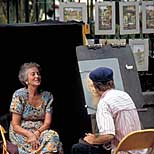
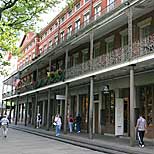
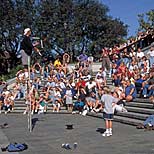
Artists, architecture & entertainers near Jackson Square
Before 1788, the French Quarter encompassed the entirety of New Orleans. Today the “old square “ (Vieux Carre), a six by twelve block parcel of land set on the inside of a bend in the Mississippi River, remains New Orleans’ most definitive area. While the city’s European heritage is readily discernible through its architecture, cuisine, social structure and the mannerisms of its people this holds true in the French Quarter more so than any other of the city’s neighborhoods. This small geographic space is personified by the diversity of interests and cultures represented here – now and historically. The French, Spanish, Anglo-Saxons, Italians, Germans, Irish, Africans, gay, straight, asexual, intellectuals, idiots, vagabonds, spinsters, debutantes, civilized, ribald, wealthy and penniless – they all have their marks on this place. A common trait shared by those who feel at home in this place is a longing to be free of the bonds of more ordinary, conservative societies. That yearning is the only cost of admission into what remains the most interesting of the world’s clubs.
The ideal time to visit the French Quarter is spring (early March – mid-May) when flowers, including brilliant multi-hued azaleas and fragrant wisteria, are in bloom. Days are generally warm, averaging 77F, and nights are cool, averaging 61F. The skies fairly sparkle and humidity is low. Festivals are numerous and include the Tennessee Williams Literary Festival and the French Quarter Festival.
Mid-October through mid-November are also highly desirable with highs of 72F and lows of 55F.
A car is unnecessary for exploring the French Quarter. The space is relatively compact and parking is a nuisance. Invest in a comfortable pair of shoes and wear lightweight clothing. Move at a leisurely pace. There is plenty to do and see and no reason to do it all in one day – if you can in any way avoid it.
People who live in the French Quarter – locals refer to them as “Quarterites”- are often content to sit upon their front “stoops” (steps) or balconies and simply watch the cast of characters go by or observe the play of dappled light and shadow upon the aged structures around them. These quiet activities are not to be overlooked by the visitor. Jackson Square, the benches outside of St. Louis Cathedral, Woldenburg Park and the Moonwalk are among the many public places where visitors can partake in simple, fulfilling observation. On weekends and most other days when fine weather prevails, the Square is a particularly popular spot for romantic couples and young parents and their children. Casual performance artists ply their crafts around the edges of the square. Mime artists, psychics, musicians, break dancers, jugglers, unicyclists, tap dancers and portrait artists can provide hours of fascinating entertainment.
Architectural styles within the French Quarter contribute greatly to the pleasures of simple observation. They are distinctive in that they are not wholly French or Spanish but an amalgamation of the two. Building types known as “Creole cottages,” “Creole townhouses,” and “shotguns” dominate the landscape. Many are embellished with trim and brackets from any number of styles popular during the Victorian era. As in old Europe, private residences are often housed directly above commercial spaces. The French Quarter’s famous, colorful “hanging gardens” can be seen flowing down from the lofty iron-laced balconies above the sidewalks. A leisurely stroll will reveal narrow, gated passages between buildings that lead to private tropical courtyards at the rear of many buildings.
As a general rule most of the French Quarter sights visitors will recognize from picture books are located “above” St. Peter street (The Upper French Quarter). The buildings are often three or four stories high and adorned with wrought iron. Popular bars, clubs and restaurants are located here, as are a number of historic homes, museums and the elegant antiques shops, boutiques and galleries of Royal and Chartres streets. Music pours fourth from doorways at all hours and a party can be unearthed with minimal effort.
Conversely, the area located “below” St. Ann street (The Lower French Quarter) offers a greater feel for what it is like to really live in the French Quarter. The buildings here are generally smaller and less ornate. Private homes and gardens are numerous. They share the blocks with eclectic shops, bars, and restaurants, which serve the neighborhood residents while also welcoming visitors in to experience this very enchanted little universe.
Jyl Benson is a New Orleans-based writer and publicist and frequent contributor to Time, New Orleans, St. Charles Avenue and the Times Picayune. She also regularly contributes to travel and guide books on New Orleans and the Gulf Coast.
Related Articles
JOIN THE NEWSLETTER!
Katrina Gives New Meaning To Refrigerator Art
October 21, 2005 – Imagine the skankiest, stinkinest, nastiest, knock-you-down, most sickening smell in the world, then add some. New Orleanians returning home weeks after evacuating for the hurricane faced refrigerators from Hell among the clean-up miseries. Most gave up on kitchen appliances gone toxic, just strapped them up with duct-tape and hauled them to the street for pick-up and proper disposal by the EPA. But the French Quarter harbors a high percentage of artists, not to mention an above average quotient of wise-asses so art and political graffitti blossomed in unlikely places post-Katrina. Alas, beauty and satire are all destined for the dump – someday soon.
Note: As off Friday October 21, refrigerators artful and not, are gone from about half the streets in the Quarter. The pick-up crews are making steady progress. Across New Orleans the EPA reports that some 3000 appliances a day are processed in the New Orleans East toxic dump station.
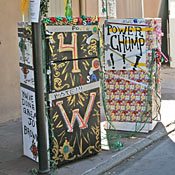
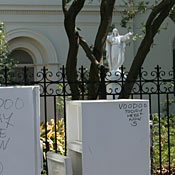
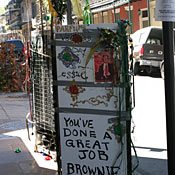
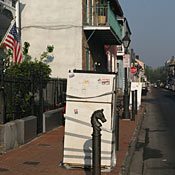
The Fun (and Funky) Fridges of the French Quarter
If you’re visiting the French Quarter, check out all of your options – here’s the list of open restaurants, hotels and shops plus their Katrina hours of operation.
Related Articles
JOIN THE NEWSLETTER!
Incredible Victory: The Battle of Midway

Never-before-heard oral histories highlight American sacrifices in War’s turning point.
The National World War II Museum in New Orleans presents a special exhibition on the Battle of Midway, one of the most pivotal – and uncertain – military battles of World War II. Incredible Victory: The Battle of Midway tells the story of the dark days in 1942 after Japan’s attack on Pearl Harbor, when the fate of the nation – and the world – hung in the balance.
“The Battle of Midway was intended to be a decisive victory for the Japanese, but because of the unbeatable spirit and determination of the United States military and citizens, it became an incredible victory for the United States,” says Gordon H. “Nick” Mueller, Ph.D., Museum President and CEO. “This victory turned the tide for the United States on the War’s Pacific front after six months of defeats and displayed for the world the American resolve that would eventually win World War II.”
Photographs and artifacts, along with never-before-heard oral histories, will honor the many heroes of Midway, including the shipyard workers who insured that the USS Yorktown – which was badly damaged in the Battle of Coral Sea – was battle ready in only three days; America’s code-breakers who enabled the country to turn Japan’s surprise attack around; and the 307 Americans who lost their lives fighting valiantly against a seemingly invincible Japanese naval and airpower contingent.
The Museum’s Research Department located and interviewed surviving veterans of the battle, whose personal accounts add a personal and emotional layer to an already epic underdog story. Additionally, archival footage from the battle will be juxtaposed against footage of how the island looks today.
The opening of Incredible Victory will be celebrated by a day-long Midway reunion including some of the veterans interviewed for the exhibit. Dusty Kleiss, Harry Ferrier, Lloyd Childers and several other heroes of Midway will be on hand for panel discussions along with prominent Midway historians. For more information, visit www.nationalww2museum.org.
The exhibition will be on display in the Museum’s Special Exhibits Gallery of the E.J. Ourso Discovery Hall through October 28.
The National World War II Museum in New Orleans is designated by Congress as “America’s National World War II Museum.” It interprets the American Experience during World War II years and celebrates the American Spirit, the teamwork, optimism, courage and sacrifice of the men and women who won World War II and promotes the exploration and expression of these values by future generations.
For more information on programs and exhibits at The National World War II Museum, visit www.nationalww2museum.org, or call 504-527-6012. To arrange group visits for schools, churches and synagogues, reunion groups, and other organizations, please call 504.527.6012, ext. 222.
Related Articles
JOIN THE NEWSLETTER!
So Much Good Food, So Little Time
French Quarter dining is a celebration of culinary excellence. From the traditional to the exotic, the Quarter offers a delectable variety of restaurants, cafes, coffeehouses, patisseries and delis.
New Orleans is known for fine Creole cuisine, which combines Louisiana ingredients such as seafood and local produce and seasonings with classic European cooking techniques. For over 100 years the French Quarter elite have enjoyed dining at elegant institutions such as Galatoire’s, Arnaud’s and Antoine’s.
Created by the French-speaking Acadians of southern Louisiana, Cajun cooking has gone from a modest regional cuisine to a style imitated the world over. Not spicy so much as flavorful, experience the real thing at K-Paul’s Louisiana Kitchen or Alex Patout’s.
Fresh seafood is abundant in the New Orleans. Raw oysters at the Acme Oyster House, fried shrimp and catfish at Deanie’s and grilled redfish at the Redfish Grill are just some of the options for seafood lovers. For those who prefer “meat and potatoes”, Dickie Brennan’s Steakhouse offers a 24 oz. Porterhouse as well as more modest steaks. A more casual option is Port of Call on the edge of the Quarter, serving ½ lb. burgers with a baked potato rather than fries.
Cafes and coffee houses can be found on almost every block in the French Quarter, but no visit to New Orleans is complete without a stop at the Original French Market Coffee Stand, Café du Monde. Café au lait and warm beignets are available 24 hours daily at this busy spot right across from Jackson Square.
With over 140 options to choose from, the French Quarter is a world-class destination for food lovers, and is sure to please every palate.
Susan Filipowicz is Associate Producer of FrenchQuarter.com and an enthusiastic observer of the Quarter scene. She once lived and worked in the French Quarter for two years without ever crossing Canal Street.
Related Articles
JOIN THE NEWSLETTER!
Catching a Bite Between Beads
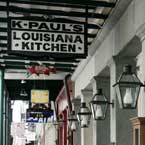
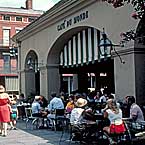
Two Fun & Iconic Mardi Gras Sustenance Stops: K-Paul’s Louisiana Restaurant and Cafe du Monde
People come to New Orleans ready to dig into America’s most distinctive and celebrated regional cuisine. This is, of course, no problem. . .unless your visit is during the riotous days leading up to Mardi Gras.
Many of the rules and norms by which the city operates are thrown out the window like so many strings of beads during this extraordinary time. Parades completely shut down major streets for long stretches and the city’s population swells to twice its normal numbers, with most of those new people crammed into the French Quarter and the neighborhoods around the Uptown parade route on St. Charles Avenue. Many businesses close or change their hours, restaurants are swamped with eager patrons or are simply inaccessible behind police barriers and rolling parades.
Even under these circumstances, however, no trip to New Orleans is complete without good, local food. More importantly during Carnival, regular meals can serve as both a sanity check and a chance to gird yourself for the next phase of the party.
Happily, revelers need not resort to bloody Mary garnishes alone for their sustenance. Below are recommended establishments that are inexpensive, good and accessible even during Mardi Gras madness. There are no guarantees about Fat Tuesday itself, though, so keep your itinerary flexible.
K-Paul’s Louisiana Kitchen, (416 Chartres St., 504-524-7394), the home base of the world famous Cajun Chef Paul Prudhomme, is one of the most celebrated restaurants in New Orleans, and on normal nights well-heeled patrons line the sidewalk waiting their turn for a table. On Mardi Gras day, however, the normal restaurant operation shuts down and K-Paul’s sells outrageously delicious food out of its dining room window. For the past few years, K-Paul’s has been serving fried ham and cheese po-boys – that is, an entire po-boy battered and fried, bread and all. Red beans and rice or redfish courtbouillon, both served in plastic bowls, are also popular. This is certainly among the best food served on the streets of the French Quarter.
Café du Monde (800 Decatur St., 504-525-5544) closes only for Christmas day and the occasional hurricane threat, and Mardi Gras is no exception. This is the quintessential New Orleans destination for beignets – the square Creole donuts – and café au lait made with rich chicory coffee. Service is always fast and the menu presents little room for indecision: the beignet, three to an order for less than $2, is the only food item served. Many a feather boa has been dusted by powdered sugar falling from these fried delights, Mardi Gras or not, and there is a take-out window for even faster service.
Angeli on Decatur (1141 Decatur St., 504-566-0077), surrounded by bars in the lower Quarter, is a go-to place for late-night eats throughout the year. The colorful dining room is peopled with a diverse crowd and the staff is accustomed to off-the-wall antics. The menu is extensive, with a pan-Mediterranean theme of pizzas, hummus, pastas and breakfast dishes. All of the sandwiches are served on excellent bread, which makes even the simple grilled cheese exciting. Vegetarians can also do quite well here, with meat-less pizzas, large salads and a very good Portobello mushroom sandwich.
Zydecue Bayou Barbecue (808 Iberville St., 504-565-5520) is located just steps away from the pulsing madness of Bourbon Street, but its kitchen is all business when it comes to barbecue. Influenced more by south Louisiana traditions than the well-known Texas or Carolina barbecue styles, Zydecue serves cochon de lait (or Cajun roast pork), fried boudin sausage and a thick gumbo along with ribs, pulled pork and beef brisket. Portions are large and inexpensive, and, since most of the dishes are smoked well ahead of time, they can be served quickly to large crowds. Zydecue will experience its first Mardi Gras in 2005.
The Country Flame (620 Iberville St., 504-522-1138) serves inexpensive, fast Mexican and Cuban food in a dark barroom environment one block off the parade route on Canal Street and two blocks down from the unceasing action on Bourbon Street. The restaurant is no frills, but stick to the specialties and you’ll have a filling meal for very little money in no time. Pressed Cuban sandwiches are among the best in town, and the ropa vieja, another Cuban recipe of shredded beef over rice, is also a good choice.
The Quartermaster Deli (1100 Bourbon St., 504-529-1416) is a 24-hour nellie deli located on the (relatively) quiet end of Bourbon Street. The Quartermaster has a sprawling menu of buttery comfort food, barbecue, greasy breakfast stuff and big sandwiches. They also deliver and will bring liquor, beer and wine to your doorstep as well.
Verti Mart (1201 Royal St., 504-525-4767) is another 24-hour, everything-but-the kitchen-sink-style deli, very similar to the Quartermaster. Combination plates and side dishes are filling, inexpensive and provide rare, precious vegetables to the Mardi Gras reveler. Creamed spinach, gigantic stuffed potatoes and elaborately layered seafood and meat po-boys are among their specialties.
Ian McNulty is a freelance food writer and columnist, a frequent commentator on the New Orleans entertainment talk show “Steppin’ Out” and editor of the guidebook “Hungry? Thirsty? New Orleans.”
Related Articles
JOIN THE NEWSLETTER!
Long Absent Cupola Returns to the Presbytere
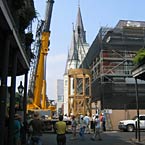
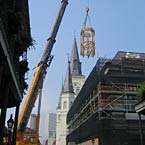
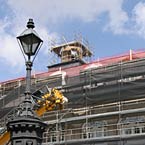
Raising the Restored Presbytere Cupola
Most people gaze upon the beautiful panorama of Jackson Square and observe the symmetrical layout of the buildings. The Presbytere and the Cabildo flank St. Louis Cathedral like mirror images. Yet, astute observers will notice one very small difference between the two historic State Museum properties. The Cabildo is topped with a classically designed cupola. The Presbytere is not. This was not always the case and will not be the case for much longer.
The Louisiana State Museum is three quarters of the way through a 10 month restoration project that will not only repair the roof of the Mardi Gras themed museum but will top it off with a cupola identical to the one on the Cabildo. Local firm Yeates & Yeates Architects, L.L.C. has designed the cupola and other renovations and Brice Building Company is handling the construction.
This project presents a unique opportunity for necessary repairs as well as a chance to honor the lost architectural heritage of a magnificent and historic building.
Construction on the Presbytere began in 1797 during the Spanish Colonial period, and was completed under the Americans in 1813. The building underwent major renovations in the 1840s after the Baroness Pontalba built the famous Pontalba apartments. Imposing mansard roofs, a third floor and matching cupolas crowned the Presbytere and Cabildo and for the rest of the 19th century the two were like twin sisters overlooking the public square.
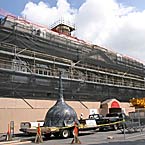
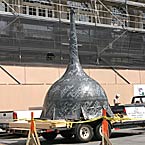
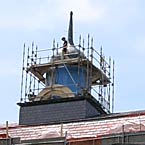
Raising the Restored Presbytere Cupola
The original Presbytere cupola lasted more than 60 years. On September 29, 1915 a Category Four hurricane caused major damage to the New Orleans area, uprooting live oaks, flooding parts of the city and destroying or damaging several landmark structures. The exterior structure of the Presbytere’s cupola was demolished. Due to lack of funds at the time, the roof was patched without a cupola and remained bare for almost a century.
Oddly enough, another hurricane would play a role in returning the Presbytere to its previous architectural condition. Wind and water damage from Hurricane Georges on September 28, 1998 compounded by damage from a freak hailstorm, forced state officials to address a major renovation project to repair the roof and exterior of the building. Louisiana State Facility Planning and Control officials, museum director James Sefcik, and the architect for the restoration Ames Yeates made the decision to restore the building to the way it was when the State Museum acquired it in 1911.
Yeates noted that while his office was doing field investigations they discovered that the central heavy timber structural ring that supported the original cupola was still in place in the attic area. The new cupola will be supported from this original heavy timber ring. Also among their discoveries was the patched indention in the roof where the original structure had been extended through the roof to the attic.
This project will be made possible due to $1,974,270.00 in state capital outlay funds and insurance settlements from the recent storm damage. The restoration is scheduled for completion in October 2005. During the renovation, the museum remains open to the public on Tuesdays-Sundays from 9 am-5pm.
For more information on the cupola renovation or the Louisiana State Museum call 504-568-6968 or 800-568-6968 or visit http://lsm.crt.state.la.us.
Related Articles
JOIN THE NEWSLETTER!
Beignets Are Back!
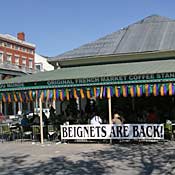
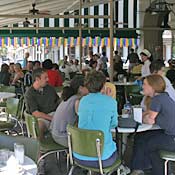
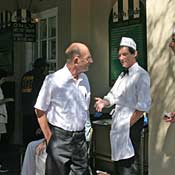
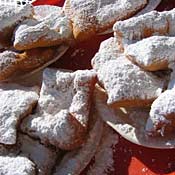
Top to bottom: Cafe du Monde signage “Beignets Are Back!”; Patrons enjoying CDM’s first day back in business after Hurricane Katrina; CDM manager welcoming devoted patrons; Sweet New Orleans confections – beignets!
October 13, 2005 – Sweet white dust clouded the air over Jackson Square Wednesday morning and nobody in New Orleans was complaining. Powdered sugar coated beignets were back and steaming cups of cafe au lait flowed freely as the landmark Cafe Du Monde in the French Quarter reopened after a seven-week forced shut-down compliments of Hurricane Katrina.
The storm knocked out power and water to the French Market icon and scattered its employees all over the country. In the interim the Fernandez family, long time owners and managers of the ultimate New Orleans sidewalk meeting place took advantage of the hurricane holiday to steam clean the restaurant, replace old fryers and kitchen gear and shine the old coffee stand to a fare-thee-well. Normally Cafe Du Monde is open 24 hours a day closing only for Christmas Day and goes through a 2.5 ton mountain of flour every week.
It’s de rigeur in New Orleans for revelers to close out a long night of partying and playing in the French Quarter with a bracing round of chicory laced coffee and several orders of the beignets. The square pillows of floury cake are deep-fried to order and don’t even have a passing resemblance to the round glazed donuts known in the rest of the country. Some people say beignets are addictive.
All day Wednesday a cheerful and steady crowd of local beignet addicts, Quarterites, for-real visiting firemen, curious relief workers and even hardy tourists enjoyed the reawakening of a beloved institution.
Thankfully, as it has for a century and a half, Cafe Du Monde is back serving up a little bit of New Orleans heart and soul every day.
If you’re dining in the French Quarter today or tonight, check out all of your options – here’s the list of open restaurants and their Katrina hours of operation.
Related Articles
JOIN THE NEWSLETTER!
Dancing to Latin and Louisiana Sounds in New Orleans
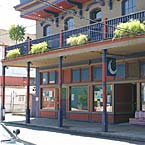
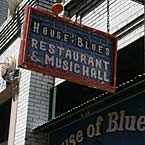

Top to Bottom: Hot Venues for Latin Music – Blue Nile, House of Blues, Tipitina’s Uptown.
Cajun and Zydeco
In Uptown New Orleans, the likeness of R&B legend Professor Longhair looks down on the dance floor of Tipitina’s (501 Napoleon Ave., 504-895-8477), a landmark music hall named for one of his tunes. But on early Sunday evenings, from 5 p.m. to 9 p.m., all eyes are on Bruce Daigrepont, who has hosted the Cajun Fais Do-Do at Tipitina’s for years. ‘Fais do-do’ is a Cajun term for a traditional dance party, and people certainly show up at Tipitina’s ready to dance. Skill levels vary from native Cajuns who seem born to sweep across the planks of a wooden dance floor to eager visitors learning their first steps together. Veteran band leader Daigrepont, backed by accordion, fiddle and a tight rhythm section, mixes up traditional Louisiana French music with original Cajun and Zydeco material for a very danceable blend.
A trip to New Orleans is enough to make most people want to dance in the streets — and it’s many a visitor who doesn’t bother resisting this inclination along Bourbon Street on any given night. But the city also offers a multitude of more structured opportunities to cut the carpet with a variety of theme nights and venues around town.
For a city heavy on its homegrown traditions — especially musical traditions — New Orleans has openly embraced dance styles of other cultures. While there’s nothing particularly ‘New Orleans’ about Latin American salsa dancing, for instance, it seems to fit the sultry feel of the city. Take a walk down Frenchmen Street, just across Esplanade Avenue from the French Quarter, on almost any weekend night to see how salsa tastes in New Orleans.
First stop would be the Blue Nile (532 Frenchmen St., 504-948-2583), where local Latin crooner Fredy Omar takes the colorful stage most Friday nights. A flamenco show kicks off the evening early at 7:30 p.m. and leads into free salsa dance lessons at 9:30 p.m. before Omar performs around 10:30 p.m.
Across the street and just down the block, Café Brasil (2100 Chartres St., 504-947-9386) has been a dance destination for years. Salsa is a mainstay, though the schedule can be a little unpredictable. No matter, when the place is on, it is obvious, with the crowd spilling out onto the sidewalk where a second band might be set up playing for people outside.
A little further down Frenchmen Street, the music and dance steps change tempo a bit. Café Negril (606 Frenchmen St., 504-944-4744) is a Caribbean restaurant early in the night, but on Friday and Saturday evenings the dining room tables are quickly crowded out by dancers and reggae bands. Steel drums echo, dreadlocks swing and Red Stripe beers keep flowing at this late night, island-inspired scene.
Things get going late indeed at the Rumba, a Latin music dance party held on Fridays at the House of Blues (225 Decatur St., 504-529-2583) which doesn’t start until the evening’s concert crowd has been ushered out around midnight.
Tango Time
Dancing the tango was such a rage in New Orleans early in the 20th century that a portion of the French Quarter crowded with dancehalls was nicknamed the Tango Belt. While discos are far more common in the Quarter now, tango has made a sustained comeback in recent years and today turns up in unexpected places.
The normally cool and collected vibe at the bar of the Loft 523 boutique hotel (523 Gravier St., 504-304-4555) gets downright steamy on Tuesday evenings with Planet Tango. Practically hidden down a side street in the Central Business District (though only two blocks from the French Quarter), the bar’s deconstructed, understated ambiance channels most of the attention to the dancers. Instructors show up at 8 p.m. to give free lessons to the uninitiated, and the real action gets going around 9 p.m. A D.J. provides the music, and there is generally no cover.
A similar tango scene develops at Mimi’s in the Marigny (2601 Royal St., 504-942-0690) on Wednesday evenings after 9 p.m. The comfortable, stylishly-renovated bar has become an instant classic in its bohemian neighborhood, and provides an appropriately sultry venue for Argentina’s sensuous dance obsession. The dance floor is upstairs, where large windows are kept open most of the time to take the breezes coming off the nearby river. Iron balconies provide excellent perches to cool off between numbers and enjoy the intriguing view both outside and back inside on the dance floor.
Many of the same moves are on display at Mulate’s (201 Julia St., 504-522-1492), a Cajun restaurant which features traditional music and dancing each night. Its location directly across from the convention center and close to the cruise ship terminal means Mulate’s is highly accessible to guests of the many downtown hotels, which is reflected in the usual crowd here. A regular roster of Cajun bands and performers, including La Touche, Jay Cormier, Lee Benoit and Jonno, give visitors a convincing reason to work off their catfish dinner on the dance floor.
Cajun twang gives way to the more funky rhythms of Zydeco at Mid-City Lanes Rock ‘n’ Bowl (3000 S. Carrollton Ave., 504-861-7000), a combination music hall and bowling alley where accordions and guitar riffs are punctuated with the thunder of strikes and groans of gutter balls. Thursday’s dedicated Zydeco Night in particular brings out the dancers, who get to see top touring acts direct from south Louisiana. Rock ‘n’ Bowl’s large dance floor gets a different type of workout on Wednesdays, which is Swing Night. The music has a retro sound, and many in the crowd turn up dressed in a retro look with big skirts and fedora hats. A dapper outfit isn’t necessary to have a good time, however, just a desire to move your feet.


